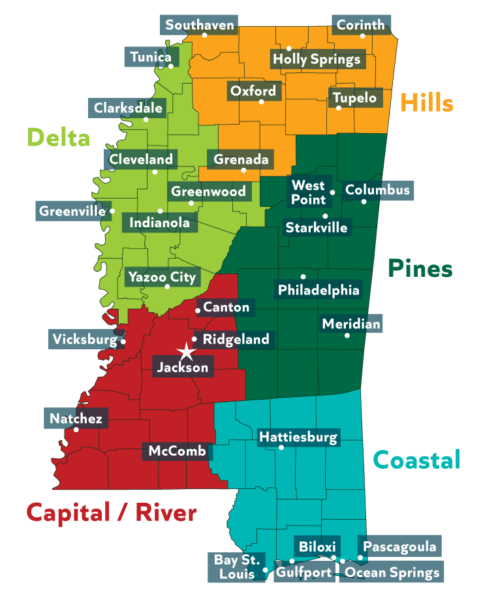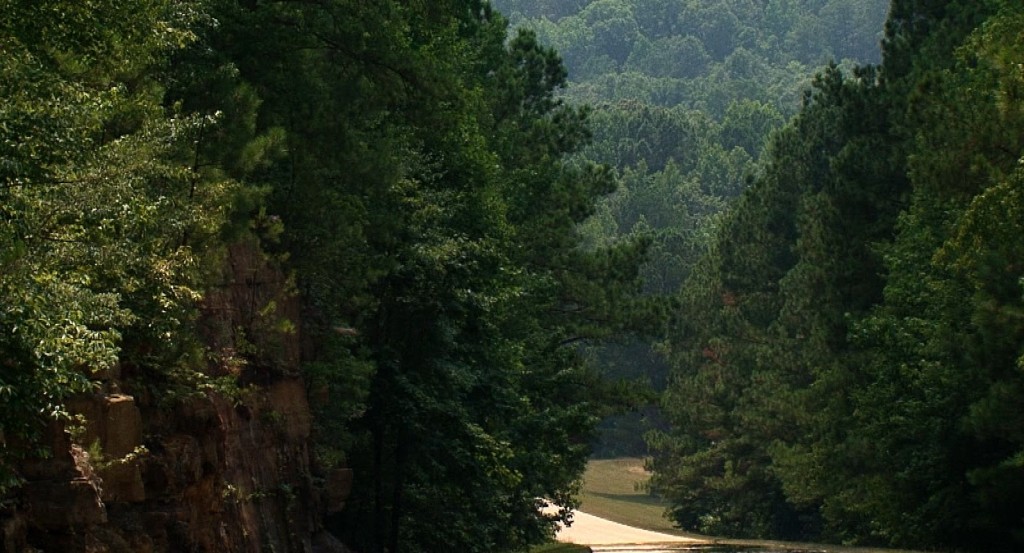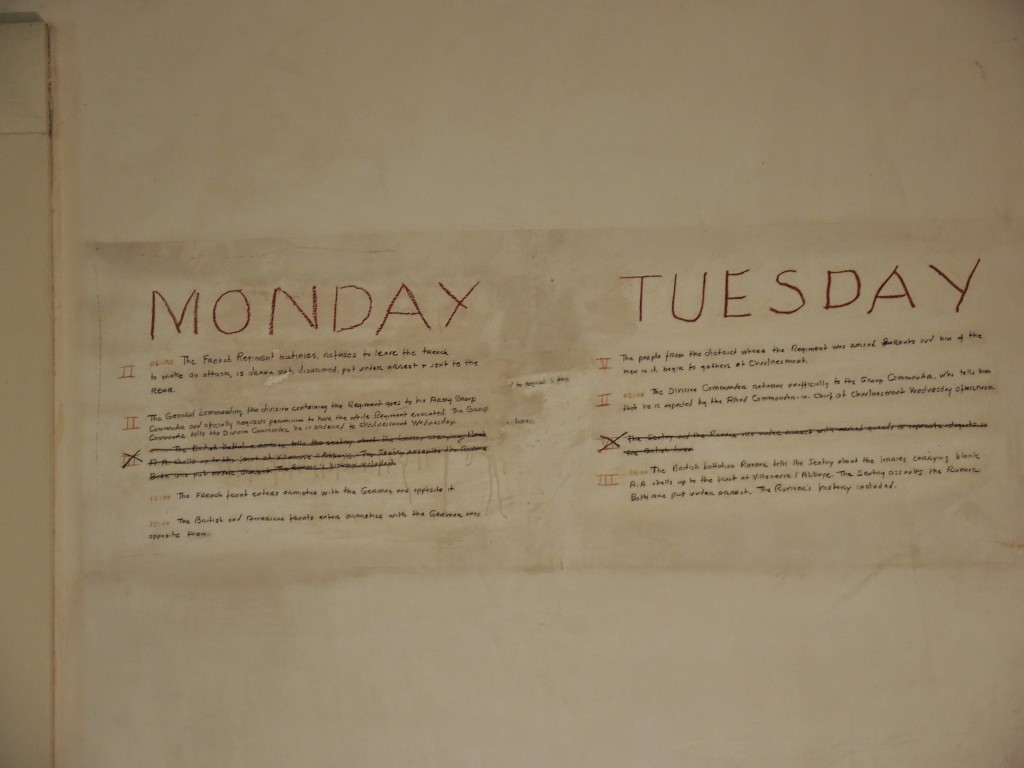My home state of Maryland sometimes calls itself America in Miniature because of the topographic variety within its relatively small borders. From the sandy dunes and seacoast of the east to the pine groves in the mountains to the west, my tiny state contains several unique regions that the state promotes as analogous to the breadth of the nation.
Like Maryland, Mississippi has distinct geographic regions of its own. The area I’ve contained my visit to the Delta. It’s not truly a delta but rather an alluvial plain situated between the Yazoo and Mississippi Rivers that’s distinct from the Mississippi River delta. The Delta Region covers most of the northwest part of the state. Clarksdale, while not the northernmost town (think Tunica), is in the northern part of this region.
The northeast region is called the Hills. Oxford, my last destination before I return to Clarksdale, is in the Hills about 60 miles nearly due east of Clarksdale. South of the Delta, the Capital River Region encompasses Jackson, the state capital, and the cities of Vicksburg and Port Gibson. Nestled between the River and the Hills is the region called the Pines. The fifth distinct area is the Coastal Region.

(From filmmississippi)
I’ve included this brief geography lesson because I want to provide some context when I begin to wax a bit rhapsodic about the drive from Greenwood to Oxford. Please don’t mistake me and think I’mm immune to the charms of the Delta.
Yes, those are herons rising out of the field. The soil is rich and marshy and some of the most productive farmland in the world. But the land is flat – every bit as flat as it appears in the picture – and driving through it for hours can become monotonous. The course I charted for Sunday is roughly a triangle. Greenwood is about 60 miles southeast of Clarksdale. This makes the second leg of the triangle – the drive from Greenwood to Oxford – about 80 miles. Leaving Oxford, I’ll complete the triangle driving 60 miles west on U.S. 278.
You may recall that Saturday, I’d driven through the most northern reaches of the Delta from Memphis to Tunica, across the river to Helena, Arkansas, and eventually into Clarksdale. Sunday morning I drove through the delta to places like Rosedale (GRR State Park), Cleveland (Dockery Farms), and Money (Bryant’s Grocery), before reaching Greenwood (Robert Johnson and Bobbie Gentry). So, for the better part of two days I’d been driving through the flat alluvial plain of expansive farms. Imagine my surprise when, only fifteen or twenty minutes outside of Greenwood I began riding through country like this: Perhaps it was the contrast but I found the ride into and out of Oxford among the most scenic of the trip.
Perhaps it was the contrast but I found the ride into and out of Oxford among the most scenic of the trip.
As I neared town, I road construction and detours again utterly baffled my GPS. In this instance, even the paper maps provided no assistance because they weren’t detailed enough with respect to this town of 18,000 (double that when the full student body of the University of Mississippi is on campus). After a series of ‘Ole Miss turns’, I bungled my way onto campus and found the University of Mississippi museum. There, someone directed me to Rowan Oak (or as the student intern who greeted me at the door pronounced it Roanoke).
In 1930, William Faulkner (nee Falkner) acquired a property in Oxford that had been vacant for seven years that was known locally as “The Bailey Place.” The estate had four acres of land and a Greek revival house that had been built in the 1840s. Faulkner, his wife Estelle, and her two children from a prior marriage settled there. In 1931, they renamed the estate Rowan Oak choosing the rowan tree because they saw it as a symbol of peace and security. Walking down the main path to the house, one needs little imagination to understand the Faulkner’s view of their home. Sometime thereafter, Faulkner purchased the surrounding acreage known as Bailey’s Woods. In 1933, William and Estelle added a third child to their family, Jill. Rowan Oak remained the Faulkner’s home until his death in 1962 a few months before turning sixty-five.
Sometime thereafter, Faulkner purchased the surrounding acreage known as Bailey’s Woods. In 1933, William and Estelle added a third child to their family, Jill. Rowan Oak remained the Faulkner’s home until his death in 1962 a few months before turning sixty-five.
Though some of his best-known works were published before he moved to Oxford, it’s probable that Faulkner completed Light in August there. Among the better known titles he certainly wrote at Rowan Oak were Absalom, Absalom!, the short story collection Go Down, Moses, and his two Pulitzer Prize winning works A Fable and The Reivers. The Sound and the Fury and As I lay Dying were all published before the Faulkners moved to Oxford. He was also residing there when he won the 1949 Nobel Prize for Literature.
In 1972, Jill sold the house to the University of Mississippi to secure it as a place visitors could come to learn about her father and his work. Interestingly, while there, you learn that the town was uncomfortable with Faulkner’s presence for decades and only recently have they embraced this native son of Mississippi. As for the house itself, like most of these places, it’s full of artifacts that reflect and preserve as closely as possible the conditions in which the family lived. Early on, Faulkner wrote in the library at the front of the house. He eventually built his own writing room toward the rear. Faulkner constructed the bookshelf on the photo’s right side. Whether he was influenced by the storyboard techniques he used in Hollywood writing screenplays, or whether it was, as a plaque at the room explains because his handwritten outline was somehow bothered by a fan or a breeze, the writing room has a unique feature:
at the front of the house. He eventually built his own writing room toward the rear. Faulkner constructed the bookshelf on the photo’s right side. Whether he was influenced by the storyboard techniques he used in Hollywood writing screenplays, or whether it was, as a plaque at the room explains because his handwritten outline was somehow bothered by a fan or a breeze, the writing room has a unique feature:  This is the outline of his 1954 novel A Fable (that takes place during Holy Week in World War I) written in graphite and red grease pencil on the wall.
This is the outline of his 1954 novel A Fable (that takes place during Holy Week in World War I) written in graphite and red grease pencil on the wall.
Although he was given to bouts of binge drinking and was eventually injured when he fell from a horse in the year of his death, there’s little doubt that the Faulkners lived a comfortable life in Oxford.
Reiterating yesterday’s opening statement, I’d recommend you not visit Oxford on a summer Sunday. Nearly everything is closed. I’d hoped to have my late lunch at the Ajax Diner or the City Grocery, both on the Square. Both closed.
I found someplace open around the corner where I had a fritata with burned hash brown potatoes. It was late afternoon, I was hungry, and on the verge of getting cranky and I didn’t want to drive back to Clarksdale having to deal with Cranky Todd. So I cleaned my plate. I should add they were nice enough to give me a to go refill of iced tea at no extra charge.
Perhaps the highlight of the meal was that the manager (or owner) of the restaurant was quizzing his wait staff – who were all seated to one side of the restaurant – on the makeup of the menu, ingredients in various dishes, the different types of liquor available, etc. He was the only person serving the small handful of customers seated on the left. The process went something like this: He’d announce a question and repeat it. “Name three brands of gin available from the bar.” Then he’d come say, to me, and ask if I’d like to order a drink. He’d disappear for a few minutes, return with my iced tea, then turn his attention to the wait staff. “Name all the ingredients in the classic muffaletta.” The quiz ended a few minutes before I finished my lunch.
As for the town itself, the setting in the hills is attractive and Courthouse Square (or simply the Square) seems to be its focal point. I’d guess that on a regular business day and particularly when the campus is filled with students, it would have the feel of a nice college town. The drive out of Oxford was also quite scenic but rather quickly transitioned into the by now familiar delta landscape.
I arrived at the Shack Up planning to stay for their show Sunday night. The other of the two best known venues in Clarksdale proper, Reds, is (surprise!) closed on Sunday and I didn’t feel any great need to return to Ground Zero. Staying on the property also had the advantage of allowing me as early a night as I felt I’d need.
While I enjoyed the show at the Inn (at least the set I stayed for) it was dipped in irony. Sunday night’s act was Mike Stinson. He’s a country singer who’s originally from Virginia, spent some time in Los Angeles, and now performs out of Houston. His principal claim to fame is likely a song he wrote – The Late Great Golden State – that Dwight Yoakam covered. The irony is, of course, that I’d seen two live shows in the heart of delta blues country and neither seen nor heard any blues.
Monday, I’ll work my way down to Vicksburg with some stops along the way including one that might surprise my friends at the University of Maryland.